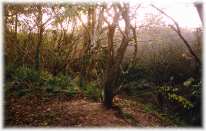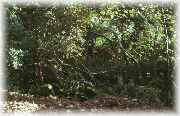![]()

ST ERTH PITS
| CLASSIFICATION
|
 |
STATUS
Cornwall's first geological nature reserve. This old sandpit, formerly known as Harvey's Pit, is now owned and managed as a nature reserve by the Cornwall Wildlife Trust. It is of national geological importance, providing evidence of the climate and geography of West Cornwall some two million years ago, in Late Pliocene times.
TYPE OF HABITAT
A geological SSSl important for its sand and clay deposits. The area covers 1.3ha
ACCESS
OS map ref SW 558 349
In the village of St Erth, south of Hayle. From Fore Street, turn left into Vicarage
Gate.At the end of Vicarage Gate, walk 100m through the playing fields and the entrance is
on the right.
GENERAL DESCRIPTION
The sand and clay deposits exposed in this and neighbouring pits are called the St Erth Beds. The blue clay element of these contains a rich and diverse fossil fauna which is dominated by sea snails and bivalves (molluscs), small bivalved crustaceans (ostracods) and single-celled animals with a toughened outer shell (foraminifera). Sponges, corals, jellyfish, colonial aquatic organisms (bryozoa), worms, sea squirts, crustaceans (other than ostracods) and fish have also been found. Plant remains include fragments of coniferous trees, broadleaved trees and shrubs, heathers, grasses, herbs, mosses and liverworts. The molluscan fauna includes 35 species of gastropod and 20 species of bivalve, but perhaps the most outstanding feature of the fauna is the amazing variety of ostracods. Deposits in the area contain the most diverse ostracod assemblage yet described in the world, including over 350 species. In recognition of its significant fossil assemblage, St Erth Sand Pits (including the adjacent Vicarage Pit) is designated as a Site of Special Scientific Interest.
SPECIES OF PARTICULAR INTEREST
Wildlife has now invaded the once bare ground of the worked pits. Semi-mature woodland - mainly sycamore, grey willow, holly and hazel - now dominates the site. Under the dappled shade of the trees, much of the shrub layer comprises bramble, nettle and hawthorn. The tangle of brambles provides ideal nesting spots for the blackcap, whose adult male is easily recognised by the glossy black cap of feathers on top of his head. Where the trees cast darker shade, a profusion of leafy ferns unfurls from the damp ground below. In contrast, where the tree canopy is open and the sun reaches the ground, butterflies bask in the heat. The peacock butterfly, which has distinctive "eye" markings on its velvety red-brown wings, is often seen in the sunny paths and glades in the summer months.
HISTORICAL INTEREST
St Erth in Pliocene times derived from the deposits and the fossils they contain is one of coastal sand-dunes which were gradually overwhelmed by beach sand being deposited by a rising sea. Sand deposition continued in shallow clayey lagoons until a further rise in sea level resulted in the formation of the fossiliferous blue clays. The fossils these contain tell us that the clay was laid down in a shallow arm of the sea that separated West Penwith from the rest of Cornwall. The waters were as warm as the Mediterranean today, between 10 and 18°C, and reached a depth of up to 10 metres. Sea level at this time was as much as 45 metres higher than today.
 |
From about 1834 until the early 1950s this area was a bustling centre of activity as the pits were worked for clay and moulding sand. The sand was moved from the pit face in small skips along a narrow tramway and then taken to St Erth railway station and sent all over the country. |
Due to its natural moulding properties, the sand was used at Harvey's Hayle Foundry for casting metal components. The sand grains were rammed into a moulding box around a wooden pattern. The thin coating of clay naturally covering each individual sand grain allowed the pattern to be removed without the sand impression collapsing inwards.
The clay from the pits was put to many uses. The famous potter Bernard Leach of St Ives frequently purchased it. It was in 1881, when the clay was being worked for the "puddling", or lining, of a new dock in Penzance, that the abundance of small marine animal fossils was first noticed.